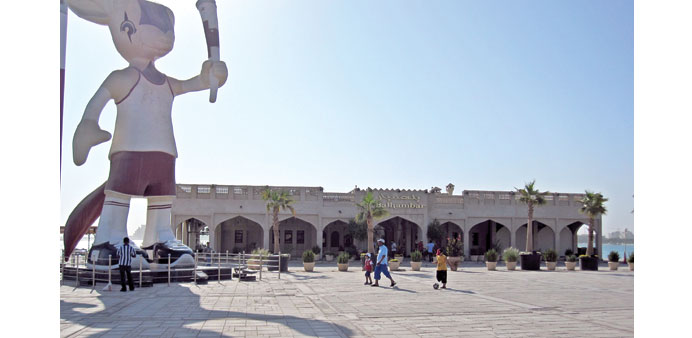As weather begins to cool down, people will start becoming more visible in parks and on corniche. File photo by Sodabottle/Wikipedia
By Steff Gaulter
If you’re new to Doha, it’s probably difficult to believe that it ever feels like anything other than a furnace here, but rest assured that this heat doesn’t last for ever. In fact, in just a few short months, the weather will be much more bearable and the corniche and the parks will be full of people.
For those of us who have been in Qatar for a number of years, we may be used to the summer, but that doesn’t make it any more tolerable. It’s still too hot to be outside for more than a matter of minutes, and we still long for cooler weather. The difference is that we have something to compare the weather to, and this year people have been asking me if it has been more humid than usual.
If you’ve been wondering that as well, you’ll be pleased to hear that it’s not just your imagination; the weather this August has been more humid than other years. Hot weather is always more difficult to cope with when it is accompanied by high humidity, because it prevents you from sweating and thereby robs your body of the ability to cool itself down. This is why it is that if the humidity is high, there is a far greater risk of succumbing to heat exhaustion or heat stroke.
The humidity in Doha depends on the direction of the wind. For the majority of the year, the prevailing wind direction is from the northwest. This brings dry air across the country and therefore the humidity is low. However, in the summer, the winds can swing round to come from the east. This doesn’t happen every day, but when it does, the winds drag in very humid air from over the waters of the Gulf and the humidity soars.
At the time of writing this, the weather so far this month has been significantly more humid than the previous few years. The relative humidity is usually given as a percentage, indicating how much water there is in the air, compared to how much there could be if the air was fully saturated. The humidity does change throughout the day, but if we just concentrate on the average for each day, between 1 and 25 August, we averaged 57%. Over the last few years, it has been generally nearer 52%. The extra 5% can and does make a significant difference to the feel of the weather.
The last time we endured higher humidity in the month of August was in 2010, when the average maximum humidity was 62%. That was not a nice summer and those of us who were in Doha may remember it as a particularly sweaty time! We can only be grateful that this August wasn’t quite as bad.
Now August is nearly over, the weather can only improve. In fact in many parts of the world September is defined as the start of autumn. Clearly things in Qatar don’t feel even remotely autumnal at the moment, but this month we should see the heat gradually start to reduce. We can expect the temperatures in September to be just a touch lower than they are currently, but there isn’t likely to be a huge difference. In August, Doha’s average maximum temperature is 40.7C (105.3F), and in September it is 38.6C (101.5F). It might not be much of a change, but it’s a step in the right direction: the heat is easing and will continue to do so until January.
Unfortunately the drop in humidity after the summer isn’t as dramatic as its arrival in July. Before the winds turn easterly and draw in moisture at the beginning of the summer, the air is incredibly dry. Moisturiser and lip balm are indispensable and drinking plenty of water is essential. At the end of the summer, however, the reduction in humidity is gradual, so don’t expect the air to suddenly become bone dry.
Over the coming weeks and months, as the weather gradually improves, new life seems to be breathed into the city. After being bleached by the sun for the past few months, rich green colours start to return to the plants and the trees. At the same time, people start to emerge from the confines of indoors, and slowly the parks begin to fill with people.
I know I’ve said it before, but I always think of this time of year as spring in Doha. We all know that it’s really just approaching autumn, but with the green shoots appearing, it gives me the same connotations of growth, renewal and new life that spring always did when I lived in the UK.
As the heat eases off, we will begin to see a greater variety to our weather. Sunshine is clearly the most predominant type of weather in Qatar, but it’s certainly not the only weather we see. Fog, rain and even hail are usually seen in the course of a year.
Anyone who’s new to Doha may be surprised to hear that we have rain at all, but the downpours can be very heavy. The ground is continuously being baked hard by the sun, so it cannot absorb the vast quantity of water which can fall from the sky during a rainstorm. Huge puddles often form, which can stick around for several days.
The thunderstorms here in Doha usually bring plenty of thunder and lightning, and quite often, some hail as well. It might sounds quite strange that somewhere as hot as Doha sees lumps of ice falling out of the sky, but it’s actually because Qatar is so hot that, when it rains, we have a greater chance of seeing some hail. The air near the ground is so dry, that rain will often evaporate before it hits the earth. However, hail melts relatively slowly, therefore if rain makes it to the surface, there’s a good chance that hail will too.
Thunderstorms are unlikely to reach Qatar in September, they are more likely in October or November. However, just three years ago it did rain at the end of September, so it can happen. As far as I’m concerned, after the hot and humid summer we’ve just had, a thunderstorm would be very welcome.



